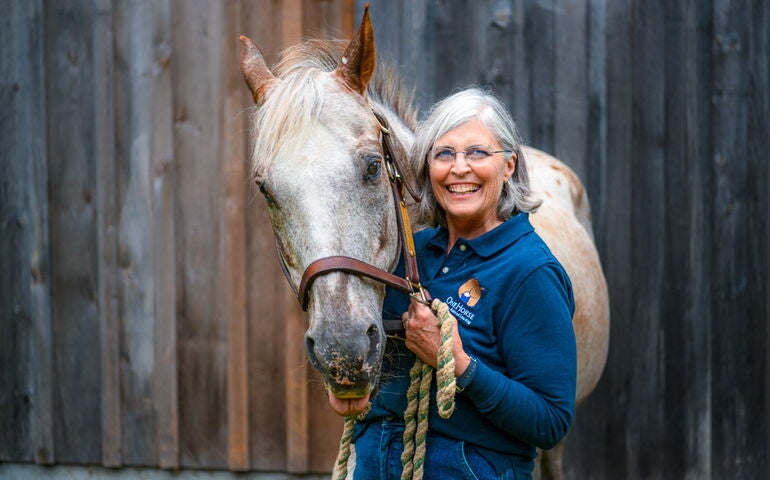On the Record: In Brooksville, a retired teacher gives literacy lessons — with help from horses
 PHOTO / JIM NEUGER
At her farm in Brooksville, Bobbi Ackerman incorporates horses into literacy lessons for children. With her is Reno, a 28-year-old Appaloosa gelding.
PHOTO / JIM NEUGER
At her farm in Brooksville, Bobbi Ackerman incorporates horses into literacy lessons for children. With her is Reno, a 28-year-old Appaloosa gelding.
On a waterfront farm in Brooksville with horses and goats, retired classroom teacher Bobbi Ackerman incorporates animals into literacy lessons for youngsters. Mainebiz visited with Ackerman at OneHorse to get the lowdown.
Mainebiz: What sparked your career path in education?
Bobbi Ackerman: Initially, I began a master’s degree in biology. I was a teaching assistant and I immediately loved helping students learn. Subsequently I became interested in how children learn and why and how some children struggle with learning.
Eventually and fortunately, I had the opportunity to teach at Landmark School in Beverly, Mass., a school for students with language-based learning disabilities.
MB: What is equine-assisted learning?
BA: Equine-assisted learning is an approach to learning based upon the relationship between a human and a horse, that promotes the development of life skills related to academic achievement, personal growth and exploration.
Horses are great learning partners because, as prey animals, they can read body language quickly and assess trustworthiness. Horses are highly attuned to their environment and to people’s feelings and emotions. And they can give feedback instantly.
Every movement of a horse — a twitch of an ear, a flicker of a nostril, the swish of a tail — is a way of communicating. And every gesture a person makes with a horse — a look, a breath, a movement of a hand — is a message.
MB: Who are your students in terms of ages, grades and learning levels?
BA: Typically, I teach students from ages 5-14 in grades K-8. Some of my students have been diagnosed with a learning disability. Most parents contact me because their child is struggling in school.
MB: Can you give examples of how you incorporate animals into literacy lessons?
BA: One activity is learning the body parts of the horse. I write words on cards and the student reads the word and tapes it on the correct part of the horse. The horse as a willing partner is a powerful support for students who are practicing reading.
Sometimes, part of the lesson can be as simple and meaningful as greeting the horse, putting on the halter, brushing and leading the horse. Many children are not used to being around creatures as large as a horse. To connect with an animal that is so attuned to who we are and to our emotions teaches children to be more aware of their bodies, their breathing, and their whole way of being.
MB: How much do you charge, and how do you keep prices affordable?
BA: Currently, I see students individually and charge $50 per session. I want everyone to afford my tutoring services. Sometimes I have reduced my fee, and there are times when I have not charged families for my services.
I would never turn a student away because of payment.
MB: What’s it like running your own business versus your previous roles?
BA: Before I began tutoring students on our farm, I taught in public and private schools. In many ways, I don’t view what I do as running a business per se. Rather, I see my work as a very personal mission to offer an equine-assisted learning approach to help students develop literacy skills.
I believe that it only takes a relationship with one horse to make a difference in a child’s life.
MB: How do you measure success?
BA: I measure success when a student can read a story that he/she couldn’t read a few weeks ago or a parent tells me that they see the difference in their child’s reading and confidence.
One student was particularly reluctant to practice reading words and sentences to me. However, one day she said she would be willing to read with Reno, one of our horses. We put a stool in his stall and she read to him while he munched his hay. After several weeks, she said she was now ready to just read to me. That’s why I teach.










0 Comments